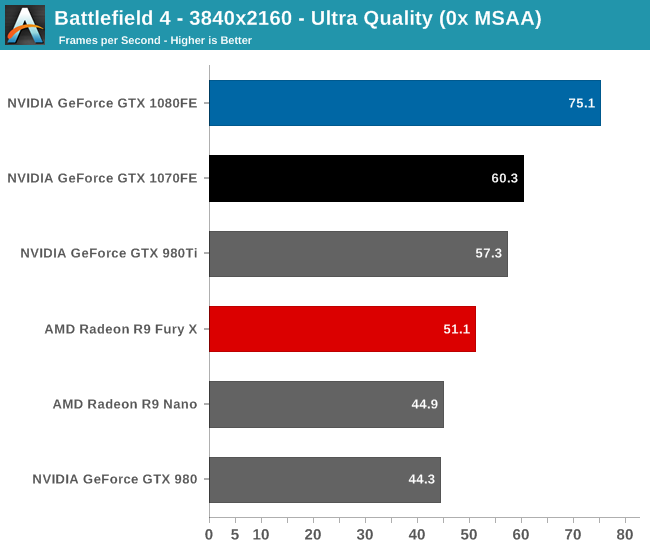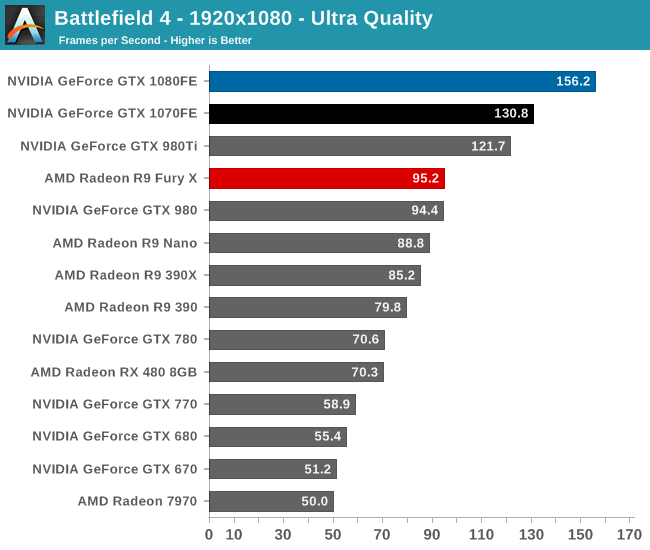The NVIDIA GeForce GTX 1080 & GTX 1070 Founders Editions Review: Kicking Off the FinFET Generation
by Ryan Smith on July 20, 2016 8:45 AM ESTBattlefield 4
One of the older games in our benchmark suite, DICE’s Battlefield 4 remains a staple of MP gaming. Even at its age, Battlefield 4 remained a challenging game in its own right, as very few mass market MP shooters push the envelope on graphics quality right now. As these benchmarks are from single player mode, based on our experiences our rule of thumb here is that multiplayer framerates will dip to half our single player framerates, which means a card needs to be able to average at least 60fps if it’s to be able to hold up in multiplayer.



As a game that has traditionally favored NVIDIA, Battlefield 4 makes for a very clean sweep of the field. The GTX 1080 takes top honors with the GTX 1070 some distance behind it. Notably, the two Pascal cards become the first cards to cross 60fps at 4K, which means that they’re the first cards we can be reasonably sure won’t have framerate dips below 30fps in multiplayer.
Looking at our standard generational comparisons, both GTX 1080 and GTX 1070 improve upon their predecessors by about what we’d expect; 67% and 58% respectively. Or to see how GTX 1080 and GTX 1070 compare, we find that the GTX 1080 leads its cut-down sibling by between 20% and 25%, with the gap increasing with the resolution. This is consistent with what we know about GTX 1080, as its bandwidth advantage means that it’s going to have an easier time pushing pixels at 4K, as the case is here.
Finally, to check in on the GTX 680, we find the GTX 1080 has only improved in performance by 2.8x, which is actually a bit less of a gain than the average. None the less we’ve gone from a card that can’t quite muster 1080p with 4xMSAA to a card that can easily handle 4K without any MSAA.










200 Comments
View All Comments
eddman - Wednesday, July 20, 2016 - link
That puts a lid on the comments that Pascal is basically a Maxwell die-shrink. It's obviously based on Maxwell but the addition of dynamic load balancing and preemption clearly elevates it to a higher level.Still, seeing that using async with Pascal doesn't seem to be as effective as GCN, the question is how much of a role will it play in DX12 games in the next 2 years. Obviously async isn't be-all and end-all when it comes to performance but can Pascal keep up as a whole going forward or not.
I suppose we won't know until more DX12 are out that are also optimized properly for Pascal.
javishd - Wednesday, July 20, 2016 - link
Overwatch is extremely popular right now, it deserves to be a staple in gaming benchmarks.jardows2 - Wednesday, July 20, 2016 - link
Except that it really is designed as an e-sport style game, and can run very well with low-end hardware, so isn't really needed for reviewing flagship cards. In other words, if your primary desire is to find a card that will run Overwatch well, you won't be looking at spending $200-$700 for the new video cards coming out.Ryan Smith - Wednesday, July 20, 2016 - link
And this is why I really wish Overwatch was more demanding on GPUs. I'd love to use it and DOTA 2, but 100fps at 4K doesn't tell us much of use about the architecture of these high-end cards.Scali - Wednesday, July 20, 2016 - link
Thanks for the excellent write-up, Ryan!Especially the parts on asynchronous compute and pre-emption were very thorough.
A lot of nonsense was being spread about nVidia's alleged inability to do async compute in DX12, especially after Time Spy was released, and actually showed gains from using multiple queues.
Your article answers all the criticism, and proves the nay-sayers wrong.
Some of them went so far in their claims that they said nVidia could not even do graphics and compute at the same time. Even Maxwell v2 could do that.
I would say you have written the definitive article on this matter.
The_Assimilator - Wednesday, July 20, 2016 - link
Sadly that won't stop the clueless AMD fanboys from continuing to harp on that NVIDIA "doesn't have async compute" or that it "doesn't work". You've gotta feel for them though, NVIDIA's poor performance in a single tech demo... written with assistance from AMD... is really all the red camp has to go on. Because they sure as hell can't compete in terms of performance, or power usage, or cooler design, or adhering to electrical specifications...tipoo - Wednesday, July 20, 2016 - link
Pretty sure critique was of Maxwell. Pascals async was widely advertised. It's them saying "don't worry, Maxwell can do it" to questions about it not having it, and then when Pascal is released, saying "oh yeah, performance would have tanked with it on Maxwell", that bugs people as it shouldScali - Wednesday, July 20, 2016 - link
Nope, a lot of critique on Time Spy was specifically *because* Pascal got gains from the async render path. People said nVidia couldn't do it, so FutureMark must be cheating/bribed.darkchazz - Thursday, July 21, 2016 - link
It won't matter much though because they won't read anything in this article or Futuremark's statement on Async use in Time Spy.And they will keep linking some forum posts that claim nvidia does not support Async Compute.
Nothing will change their minds that it is a rigged benchmark and the developers got bribed by nvidia.
Scali - Friday, July 22, 2016 - link
Yea, not even this official AMD post will: http://radeon.com/radeon-wins-3dmark-dx12/